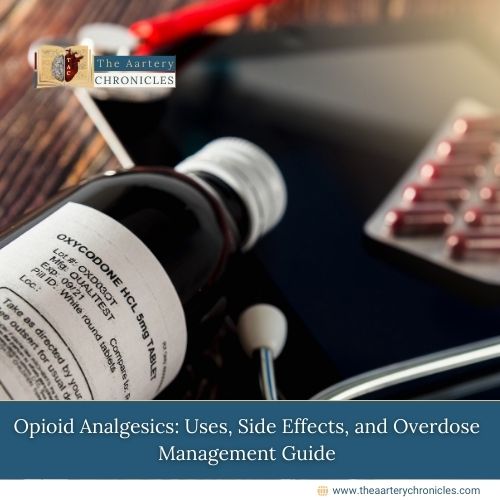

Opioid Analgesics: Uses, Side Effects, and Overdose Management Guide
Introduction - Understanding Opioid Analgesic Agents
Opioid analgesic agents are a diverse group of medications that, structurally, resemble natural alkaloids found in opium, originally derived from the opium poppy (Papaver somniferum). I’ve found that these medications are incredibly potent when it comes to managing severe pain, making them indispensable in medical settings. However, their use is not without controversy due to the risks of addiction, tolerance, and other adverse effects. In this post, I’ll explore the clinical uses of opioids, their side effects, how they work, and how to manage overdose.
Clinical Uses of Opioids
Opioids are commonly employed in various clinical scenarios:
- Acute Pain Management: Opioids are often prescribed for short-term relief of severe pain following surgeries or injuries, such as
- Post-operative pain
- Trauma-related pain
- Chronic Pain Relief: Opioids may be used to manage long-term pain for conditions such as
- Cancer pain
- Chronic pain unresponsive to other treatments
- Palliative Care: In palliative care, opioids play a crucial role in improving the quality of life for patients with terminal illnesses by alleviating severe pain and discomfort.
- Cancer Pain Management: Patients undergoing cancer treatment frequently rely on opioids to control pain that is resistant to alternative analgesics.
Opioid Availability in India
In India, the availability of opioid formulations is somewhat limited compared to other countries. However, there are some commonly available options, which I’ve outlined below:
- Morphine: Available in both tablet and injection forms, morphine is one of the most widely used opioids in pain management.
- Buprenorphine: This opioid comes in various forms, including transdermal patches, injections, and tablets.
- Fentanyl: Known for its potency, fentanyl is available in transdermal patches, injections, and even lollipop formulations for breakthrough pain.
- Methadone: Available as a syrup, methadone is another option for pain management, particularly for patients with chronic pain.
However, I’ve noticed that certain opioids like oxycodone and hydromorphone are not currently available in India. This can sometimes limit treatment options for patients who may benefit from these specific medications.
Side Effects of Opioids
Despite their effectiveness, opioids come with a range of side effects:
- Constipation: This is a common issue with opioid use, but it can usually be managed with increased fluid intake and over-the-counter remedies.
- Nausea: Some patients experience nausea, which might require switching opioids or using anti-nausea medications.
- Severe Breathing Difficulties: One of the most serious risks of opioid use is respiratory depression. I always advise patients to avoid alcohol and benzodiazepines while on opioids and to report any excessive drowsiness to their healthcare provider.
Mechanism of Action of Opioids
Opioids work by connecting with specific receptors (G protein-coupled) in the body, including mu, kappa, delta, and sigma receptors. This helps reduce pain in both the spine and brain areas:
- Presynaptic Action: Opioids block calcium channels in the nerves that send pain signals, stopping the release of chemicals like substance P and glutamate, which are responsible for transmitting pain.
- Postsynaptic Action: They also open potassium channels, which makes it harder for pain signals to travel by lowering the chance of pain messages being sent.

Managing Opioid Overdose
Opioid overdose is a serious concern, primarily due to profound respiratory depression. Key signs of overdose include
- Altered mental status
- Slow breathing (bradypnea)
- Constricted pupils
Naloxone is the recommended treatment for opioid-induced respiratory depression and can be administered intravenously, intramuscularly, or intranasally to quickly reverse the effects.
Wrapping Up
Opioids play a vital role in managing severe pain, especially in cases of acute injuries, chronic pain, and palliative care. While they are powerful tools in pain relief, their potential risks, such as addiction, tolerance, and serious side effects, should not be overlooked. It’s essential to use opioids responsibly, under the guidance of a healthcare provider, and always stay informed about potential side effects and overdose risks. With careful management and understanding, opioids can be a safe and effective option for those in need of significant pain relief.
- Centers for Disease Control and Prevention (CDC). (2022). CDC Guideline for Prescribing Opioids for Chronic Pain. Available from https://www.cdc.gov/mmwr/volumes/71/rr/rr7103a1.htm
- National Institute on Drug Abuse (NIDA). (2021). Opioids. Available from https://nida.nih.gov/research-topics/opioids
- American Society of Clinical Oncology (ASCO). (2021). Opioid Use in Cancer Pain Management. Available from https://ascopubs.org/doi/10.1200/JCO.22.02198

Dr Kavya Salian
Reviewed by: Dr Aarti Nehra








